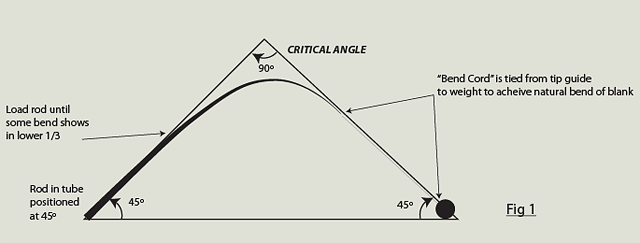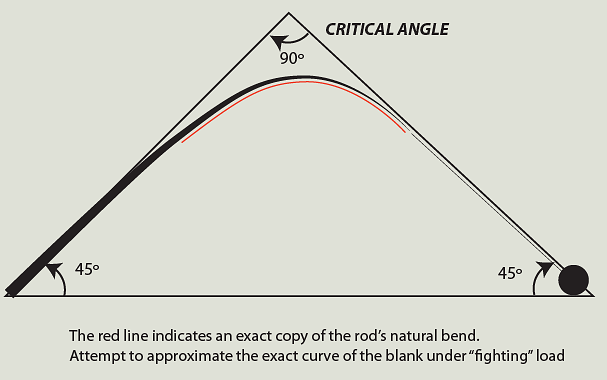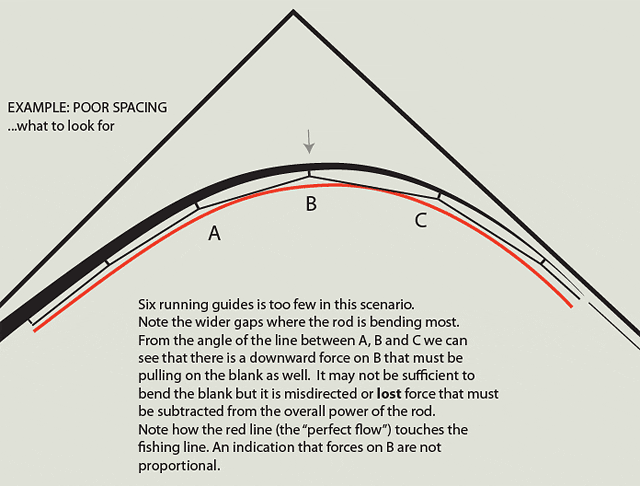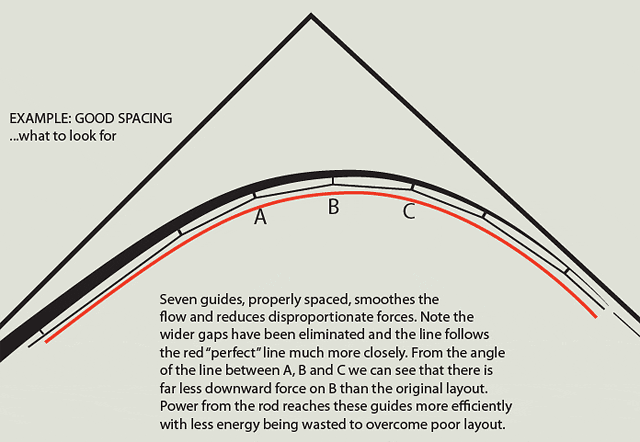
STATIC LOAD POSITIONING FOR RUNNING GUIDE PLACEMENT
IMPORTANT: BEFORE YOU BEGIN you must have the reel seat, reel (with some line), handle and tip installed. Stripper and reduction guides should be taped in place and pre-positioned running guides should also be taped on to complete this exercise. Measure the distance from the tip guide to the last reduction guide, divide this number by 5 and add that many running guides PLUS 1 more to the rod, equal distances apart.
CASTING GUIDE PLACEMENT: Setting up a casting rod is identical in principal to a spinning rod. The primary difference is placing guides to hold line away from or barely touching the blank in the 90-degree bend scenario. Begin by placing your stripper guide approximately 18 to 22 inches from the reel and work spacing from that guide. Micro rods will require 2 and sometimes 3 additional guides.
Unlike the mathematics associated with the positioning of reduction guides to increase casting distance, running (or tip section) guides have the primary job of transforming the power stored in the bend of the rod into the work of retrieving line or fighting fish. Properly positioned, these guides can make fighting a fish far more efficient and assure that the line is managed to “use” the natural bend and power of the blank without dipping low enough to add drag, create unwanted torque or introduce odd stresses that work in opposition to the rod. With so many manufacturers, blank actions and blank-to-blank variations it becomes an impossible task to “do the math” for static load positioning. Each blank is a puzzle to be solved individually. The method described below simulates a real fish fighting scenario and utilizes known information about rod dynamics. Using this method results in a guide train that works most efficiently from a deep bend position to a “peak power” position. Proper static placement will usually result in additional guides on the rod. With more guides, they can usually be smaller and lower to the blank offering weight savings, faster recovery and additional “contact points” that transmit vibration better and increase sensitivity. As you can see, the benefits of good static guide placement are substantial.
KNOWN FACTORS IN ROD DYNAMICS
A fishing rod’s ultimate job is very simple. It wants to stay straight. In any situation where it is bent, it strains to be straight again. How hard it strains is the measure of power in the blank. Power in a rod comes from two places, 1) the rod’s tendency to return to a straight position and 2) the ability of the angler to change the angle of the rod and “use” different sections of the rod to fight a fish (the word “angler” is not an accident).
The absolute peak power position is a rod pointed straight at the fish, which virtually takes the rod out of the equation and allows the angler to simply “pull” the fish in. This position is almost never used, though flycasters fighting giant Tarpon get very close to this position because it exerts so much power on the fish. Obviously, few mistakes can be made when the rod’s shock absorbing characteristics are removed from the equation, the important thing to remember is that a low rod pointed at a fish is a very powerful position.
In this position, guide placement is actually not very critical due to the straight nature of the pull. Once you understand this principal, you can also begin to see that it is possible for the angler to CHOOSE the section of rod he wants to apply in a fight. How? By noting how much of the tip section is straight. The straight section performs no work and bears no pressure so, in effect the rod becomes shorter and the power used moves down and into the stronger mid-section of the rod.
Good static load guide position allows the angler to maintain a powerful guide train in all sections of the rod as the fight progresses through an infinite variety of bends in the rod. Since the guides have little effect when the rod is straight, guide placement is most critical when the rod is in a deep bend. A rod set up for this situation easily handles less bend and more bend adequately.
“Deep bend” is best described as the bend created when the tip is perpendicular to the butt of the rod. Bends greater than 90º actually start to reduce the power in the rod and at some point result in failure. With an understanding of the extremes, both straight and bent beyond 90º, good static guide placement reflects the concept that guide position will work best when set to handle a range of bending motions centered around the 90º deep bend angle.
The most common way to accomplish this 90º bend is a PVC or similar plastic tube mounted to hold the rod at a 45º angle and a moveable weight that allows you to mirror the angle of the rod to achieve the optimum 90º load angle. The 45º rod angle is not critical, THE 90º TIP TO HANDLE RELATIONSHIP IS WHAT YOU WANT TO ACHIEVE. The diagram below illustrates this point.

At this point, with the rod loaded to simulate a 90º fighting angle, it’s time to check and reposition the location of the running guides to take full advantage of the rods characteristics. First, tighten the actual fishing line coming off the reel to provide enough tension to create a good straight line from guide to guide. Work from the tip backwards. With the rod loaded at 90º there is usually little bend in the last few inches of the tip section. For that reason it is usually safe to place the first guide 4 to 4.5 inches from the tip guide. The goal on a spinning rod is to work with the natural bend of the rod to eliminate any stress that would change the bend. To do this we must position the guides so they will compliment this curve rather than compete with it or apply any external stresses that counter what the rod is attempting to do. Proper placement here will “maximize’ the system.



Note: The final position of each guide in this layout is achieved with no measurements.
The rod’s bend determines the location of each guide. This technique often results in an
unconventional look, but performance is maximized only when the guide train is positioned
to fully utilize the energy coming from the rod.
OBSERVATIONS:
1) Properly spaced Guides will transfer as much work as possible from the blank, to the guide, to the line.
2) Poorly spaced guides apply odd angular forces. Those forces are not applied to the rod but instead, are lost. This is one reason why well spaced guides can actually increase the power of the rod and therefore the amount of pressure the angler can apply to a fish.
3) Static Load Placement will result in unconventional spacing with more guides in the deepest, most flexible bend areas of the blank and fewer guides in stiffer, stronger sections.
4) Fuji’s New Guide Concept combined with Static Load Positioning usually results in 1 to 3 additional guides that are lighter and smaller than traditional guide layouts. This configuration does a better job of maintaining rod sensitivity while more smoothly tracking the rod’s natural bend and maximizing the transfer of power from the rod to the line.
5) Fuji’s New Guide Concept recommends using the smallest ring size that will accomplish the task at hand. Consider knots, leader material, debris (such as floating grass), and any other factor that may influence your selection. Smaller guides will add sensitivity and track line through the bend of the rod more closely.
Good Static Load positioning coupled with GPS reduction guide placement results in performance levels unattainable with any other layout concept. For the lightest, fastest, strongest, longest rod possible, let Fuji help with your next rod.